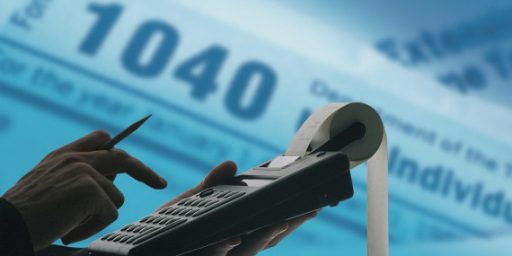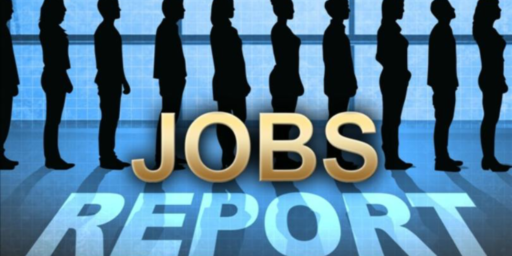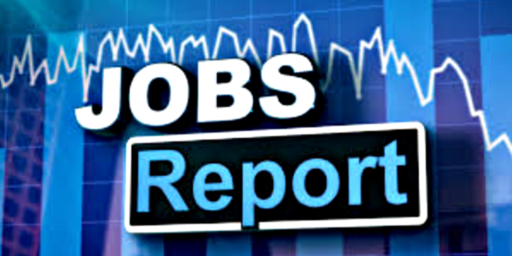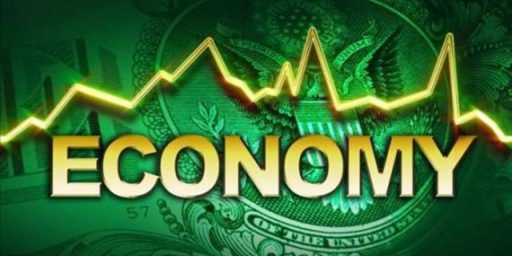A Decades-Long Stock Market Bubble?
The S&P and Nikkei are at all-time highs. Economists warn that it won't last.

An interesting report in The Economist asserts, “Stockmarkets are booming. But the good times are unlikely to last.” And, no, it has nothing to do with Joe Biden.
Everywhere you look, stockmarkets are breaking records. American equities, as measured by the s&p 500 index, hit their first all-time high in more than two years in January, surged above 5,000 points in February and roared well above that level on February 22nd when Nvidia, a maker of hardware essential for artificial intelligence (ai), released spectacular results. The same day, Europe’s stoxx 600 set its own record. Even before Nvidia’s results had been announced, Japan’s Nikkei 225 had surpassed its previous best, set in 1989. Little surprise, then, that a widely watched global stockmarket index recently hit an all-time high, too.
This is quite a turnaround. Stocks slumped in 2022, when faced with fast-rising interest rates, and wobbled last March, during a banking panic. Now, though, both episodes look like brief interruptions in equities’ long march higher. Despite middling economic growth and the covid-19 pandemic, stockmarkets have offered annual returns, after inflation, of more than 8% a year since 2010, including dividends (cash payments to shareholders, funded by company profits) and capital gains (when the price of a share increases). These returns have been better than those produced by bonds and housing. Indeed, they have been better than those produced by just about any other asset class.
If the boom has a home, it is America. A hundred dollars invested in the S&P 500 on January 1st 2010 is now worth $600 (or $430 at 2010’s prices). However you measure them, American returns have outclassed those elsewhere.
Granting that fourteen years is a long time to forgo the use of one’s funds (the time value of money and all that), a 430% inflation-adjusted return on investment is pretty good. And, indeed, those of us whose whole working life has been spent in the IRA/401k era, have much of our retirement invested in the stock market. I’ve done so going back to late 1988.
Almost 60% of Americans now report owning stocks, the most since reliable data began to be collected in the late 1980s. Many of them, as well as many professional investors, have a question. Is the stockmarket surge sustainable or the prelude to a correction?
For as long as stockmarkets have existed there have been those predicting an imminent crash. But today, in addition to the usual doomsaying, a chorus of academics and market researchers argues that it will be tough for American firms to deliver what is required over the long-term to reproduce the extraordinary stockmarket returns seen in recent years. Michael Smolyansky of the Federal Reserve has written about the “end of an era”, and warned of “significantly lower profit growth and stock returns in the future”. Goldman Sachs, a bank, has suggested that the “tailwinds of the last 30 years are unlikely to provide much boost in the coming years”. Jordan Brooks of aqr Capital Management, a quantitative hedge fund, has concluded that “a repeat of the past decade’s equity market performance would require a heroic set of assumptions.”
Why the doomsaying? Stocks have been a wonderful long-term investment my entire lifetime.
That is, in part, because valuations are already at eye-popping levels. The most closely followed measure of them was devised by Robert Shiller of Yale University. It compares prices with inflation-adjusted earnings over the previous decade—a long enough period to smooth out the economic cycle. The resulting cyclically-adjusted price-to-earnings ratio, or CAPE, has never been higher than 44.2, a record reached in 1999, during the dotcom bubble. The previous peak was in 1929, when the cape hit 31.5. It now stands at 34.3 (see chart 2).

The scale of the chart is a bit weird, cramming 20-year increments into small spaces, but it’s useful for long-term trend visualization.
Also interesting:
Rarely have corporate profits been valued so highly. And the outlook for the profits themselves is also challenging. To understand why, consider the fundamental sources of their recent growth. We have employed Mr Smolyansky’s methodology to examine national-accounts data for American corporations. Between 1962 and 1989 net profits increased in real terms by 2% a year. After that, profits accelerated. Between 1989 and 2019 they increased by more than 4% a year. We find similar trends across the oecd, a club of mostly rich countries. As a share of gdp, corporate profits were steady from the 1970s to the 1990s, then doubled (see chart 3).

But what really caught my attention was this:
Yet much of this strong performance is, in a sense, a mirage. Politicians have reduced the tax burden facing corporations: from 1989 to 2019 the effective corporation-tax rate on American firms dropped by three-fifths. Since companies were giving less money to the state, corporate profits rose, leaving them with more money to pass on to shareholders. Meanwhile, over the same period borrowing became cheaper. From 1989 to 2019 the average interest rate facing American corporations fell by two-thirds.
Mirroring Mr Smolyansky, we find that in America the difference in profit growth during the 1962-1989 period and the 1989-2019 period is “entirely due to the decline in interest and corporate-tax rates”. Extending this analysis to the rich world as a whole, we find similar trends. The surge in net profits is really an artefact of lower taxes and interest bills. Measures of underlying profits have grown less impressively.
Now companies face a serious problem. The decades-long slide in interest rates has reversed. Risk-free interest rates across the rich world are about twice as high as they were in 2019. There is no guarantee that they will fall back to these lows—let alone decline fairly steadily, as they tended to in the decades before the pandemic.
As for taxes, the political winds have changed. True, Donald Trump may see fit to cut America’s corporation-tax rate if he wins in November. But our analysis of 142 countries finds that in 2022 and 2023 the median statutory corporate-tax rate rose for the first time in decades. For instance, in 2023 Britain increased its main rate of corporation tax from 19% to 25%. Governments have also established a global minimum effective corporate tax rate of 15% on large multinational enterprises. Once it has bedded in, such companies will probably pay between 6.5% and 8.1% more tax, leaving a smaller pool of net profits.
Low interest rates are a boon to everyone but savers. Whether the lowering of corporate tax rates is good policy is certainly debatable but, of course, multinational conglomerates have arranged their accounting to shift their profits to the lowest tax jurisdictions available—usually Ireland. Roughly three years ago, there was an agreement among OECD and G-7 members to set a 15 percent floor, but its implementation has been spotty. Notably, the US Congress has (shockingly, I know) refused to go along.
Regardless, that which is unsustainable won’t be sustained.
What needs to happen, then, for American stocks to keep offering exceptional returns? One possibility is that investors pay for even more stretched valuations. In a world in which interest and tax bills remain constant for the next decade while real earnings grow at 6% a year—an optimistic scenario—America’s cape would need to rise to 51 to reproduce the overall returns seen from 2013 to 2023. That would be higher than it has ever gone before.
Now make things grimmer and assume that valuations revert towards their means. The cape drifts towards 27, near the average since the end of the dotcom bubble. Assume, too, that interest and tax bills rise. Rather than clocking in at 25% of earnings, they drift up to 35%, or around the level in the first half of the 2010s. In this more realistic world, to generate even half the returns equity investors enjoyed since 2010, real earnings would have to grow at 9% per year. Only twice in the post-war period has America achieved this sort of growth, according to Mr Brooks, and in both cases the economy was rebounding from busts—once from the dotcom bubble and once from the global financial crisis of 2007-09.
Given that interest rates are high but expected to drop soon, this is certainly an argument for diversifying one’s portfolio into bonds.
Then there’s this:
Many investors hope that ai will ride to the rescue. Surveys of chief executives suggest great enthusiasm for tools that rely on the technology. Some companies are already adopting them, and claim that they are producing transformative productivity gains. If deployed more widely, the tools may allow companies to cut costs and produce more value, juicing economic growth and corporate profits.
Needless to say, this is a heavy burden for a technology that is still nascent. Moreover, technological developments are far from the only trend that will affect business in the coming years. Firms face an uncertain geopolitical climate, with global trade flat or declining depending on the measure. In America both parties are sceptical of big business. The battle against inflation is also not yet won: interest rates may not fall as far or as fast as investors expect. In recent decades you would have been foolish to bet against stockmarkets, and timing a downturn is almost impossible. But the corporate world is about to face an almighty test.
Of course, most of the productivity gains from implementing AI is likely to come at the expense of wages, particularly for lower-skill workers.






Of course, this can also be stated as “More than 40% of Americans own no stocks, and have not participated in the boom.” How is our GINI index doing these days?
Something I’ve always wondered about is the effect of the 401K and similar qualified plans on the stock market. Every pay period, billions of dollars go into mutual funds, which in turn invest in stocks. Very few people make a change when stocks are up or down (and that’s a good thing!), so the money floods in during good times and bad. That has to affect something.
It would be interesting to add to the calculations the amount of value taken out of the Chinese stock market and genal economy. The decline there has roughly paralleled the rise of the Japanese market.
Two years ago, our financial planner began warning that expected market growth over the next 10, now 8 years would lag not only the growth seen since the trough of the great recession, but also the historic growth rate going back to the great depression. There were a number of reasons given, but a large one is that price-to-earnings ratios were at highs and not sustainable. A friend, who spent his career in wealth management, contends, somewhat perversely, that the movement of investors money into broad based equity funds has introduced too much stability to the market, i.e., there are too few large winners and large losers. What is good for the individual, isn’t necessarily good for the market as a hole.
@DrDaveT:
Well, 31% of the population is under 25 and thus not having started retirement savings. And another 17% is over 65, with many of those presumably having cashed out or transitioned to less volatile investments.
EDITED TO ADD: But I agree with your larger point that a significant number of Americans own no stocks or have very little direct stake in the stock market.
@Sleeping Dog: You made me curious so I found a chart of the PE for the S&P 500 going back 90 years. A couple of observations:
– PE is volatile as heck!
– The decades long trendline was flat (? more or less?) from just after the Great Depression market collapse until 1980
– The 401K was launched in 1978. From 1980 to 2000 there was a steady increase in PE ratio
– It started to level out in 2001 and (with the exception of the 2009 bubble) has remained relatively flat (at least, looking at the decades trend line)
– The first Boomers reached early retirement age in 2008 and, as James noted, started to pull their money out of stocks. This may explain part of the leveling off of PE ratio
IANAFIA (I am not a Financial Investment advisor, so this is mostly just me randomly speculating)
“This won’t last’ is the easiest prophecy not just in economics, but in pretty much every human endeavor. It has the advantage of being completely unfalsifiable. . . without a time frame. ‘It’ absolutely will not last forever.
So all of that increased money we put into the finance sector and CEO pay and all we got for it was decreased taxes on their companies. Awesome.
Steve
As long as it remains the policy of this country that rich people should be taxed as little as possible, the stock market is going to continue to do just fine. There’s just too much cash sloshing around, and it’s got to go somewhere…
Remember the book written around 1999, ‘Dow 36,000,’ by columnist James K. Glassman and economist Kevin A. Hassett? They predicted that the Dow would rise from around 8,000-10,000 to 36,000 by 2004.
Well the 2008 collapse of financial markets got in the way, but here we are.
No, the increases will not go on uninterrupted forever, and there will be ‘adjustments’ and ‘corrections’ along the way.
Fortunately, I am in the market long term and have enough time left before I retire (hopefully not more than 20 years from today, as I would be heading towards my mid-seventies) to let the market help me generate what will pretty much be my post work income that I can hang tough if another 1-3 “black Monday/Friday” events hits the market in that time, but yes, holy heck the swings in the market are bananas.
Around the end of last July when my father passed and for reasons I decided to peek at my brokerage account it was about 5k less than today, but sometime in December it was about 13k less than when I checked in July, but the kicker is that since December to today the total increase in say less than a hair over 2 months was 22k!!
I am still happy with a 5k increase in less than 8 months, and this is money earned without working another job, so yay, but a 22k jump in my modest portfolio in 2 months is indeed nuts
These super swings in the market pretty much did not exist 25-30 years back. Not a market for the faint of heart, lol
Same economists who spent the last two years warning a recession was around the corner? ‘No, seriously, in just a few months…Okay, just kidding, but it’s coming, for real….No really this time…’
Maybe economists should leave the tarot card stuff to fortune tellers and just wait to elucidate and explicate what’s already happened.
@inhumans99: Ayup! When my mom passed away, my brother and I divvied up about $600k. Roughly 8 years later my half is just under half a million, and I’m mostly in cash equivalents with a small equities position.
Somewhere I saw a long term chart of interest rates, as in back to the Roman Empire. Clear downward trend approaching zero. Capital has been the choke point in the economy for so long I’m not sure the Econ profession has adjusted to the fact that we’re floating on a sea of money.
And I will fearlessly predict that the current bull market will end – someday.
It doesn’t make sense to me to look at PEs in isolation. The other factor is interest rates. If a person has some money to invest, where are they going to put it? In a sock?
So, they can go to a bank and get FDIC guaranteed CDs with a low interest rate. They can get T-bills, also with a low interest rate. They can get munis and/or corporate bonds, with a higher (effective) interest rate, but more risk, or you can buy stocks. Sometimes even with a higher PE, the stocks are the best buy.
All of the above almost always beat the sock.
@al Ameda: In all fairness, given inflation $36K would be $66K today.
“Buy and hold.” “Time in the market beats timing the market.”
I read an article a few years back citing a study where dead people outperformed every other category of investor. That’s because dead people don’t react emotionally to bear/bull news.
I have found the best way to invest is to purchase two or three mutual funds at most. Determine an allocation – say 70% stocks and 30% bonds/cash – and stick with that allocation. And I choose very low cost index funds. If you are paying more than half of a percent per year in fund costs, you are being ripped off.
When it gets out-of-whack, rebalance.
This strategy ensures you “buy low and sell high”. I am not aware of any other strategies that ensure the prime directive as well as allocation/rebalancing.
And I know what I’m talking about here – I retired in my early 50s more than 5 years ago, and we’re doing just fine.
When Nvidia’s stock value is almost as much as the annual GDP of Canada, then I start to think the pendulum is nearing its high point. We are probably due for some kind of correction.
The other point to make is that defined contribution pensions, like 401k’s, are also highly dependent on stock market performance. The biggest one of them all, CALPERS, has serious market influence due having something like a half trillion dollars in assets.
But size is relative. You’d need almost four CALPERS to equal one Nvidia.
I meant defined-benefit pensions – I am dumb.
@Andy: There are different kinds of stocks and different kinds of investors. Nvidia is being chased by investors who believe they have mastered the Greater Fool game. But this type of craze is always around. The question is what about normal companies? How are they doing?
@Andy: @MarkedMan: There was a time when PriceLine.com was worth more than all the major airlines combined. That didn’t last.